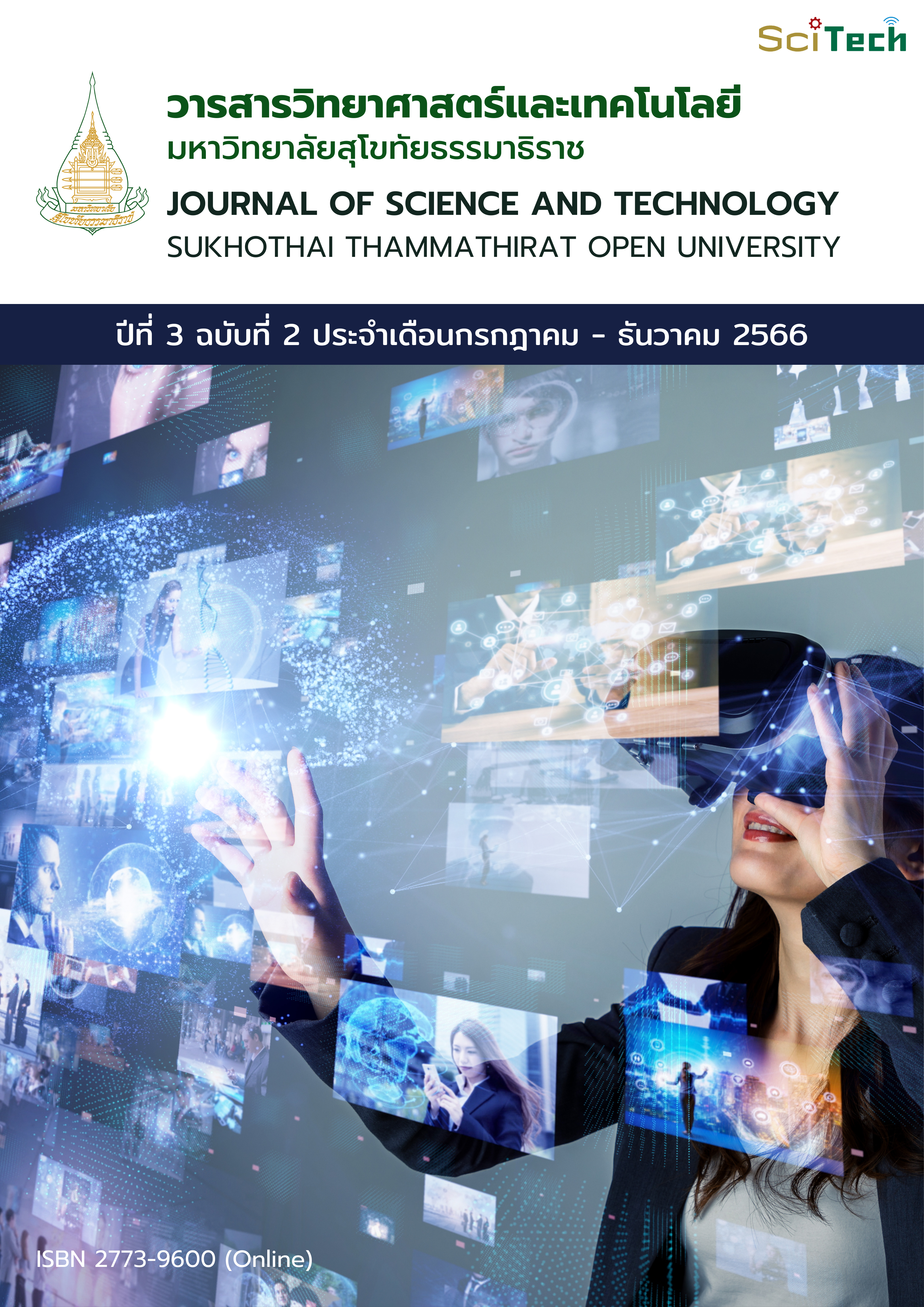Virtual reality technology for 3D printing practical training
Keywords:
Virtual Reality, 3D Printing Technology, Virtual Laboratory, Practical TrainingAbstract
Virtual reality technology is one of tools used to support learning and is essential for future education. Virtual learning provides learners with the access to a distance learning system in an environment, where the learners are in a face-to-face learning environment. This research aims to develop virtual reality media for 3D printing practical training. The research commenced with the study of using 3D printers and virtual reality technology, followed by the development of the virtual reality program of 3D printing. Subsequently, the quality of the virtual reality program was evaluated, and the efficiency of these learning materials was tested. Finally, the learning materials were refined and tested with the 30 samples of bachelor students in the School of Science and Technology from Sukhothai Thammathirat Open University, the evaluation utilized a paired sample t-test. The finding of this study revealed that students had a mean score before learning of 5.03 with a standard deviation of 1.83 before learning, and a mean score after learning of 8.07 with a standard deviation of 1.14 after learning. The students who participated in the virtual reality laboratory instructional media had significantly higher post-test scores than pre-test scores at a statistical significance level of 0.01.
References
พิชิต ฤทธิ์จรูญ (2565), เทคนิคการวัดและประเมินผลการเรียนรู้. ซีเอ็ดยูเคชั่น
ศยามน อินสะอาด (2561), การออกแบบบทเรียน e-Learning เพื่อพัฒนาทักษะการคิดขั้นสูง. ซีเอ็ดยูเคชั่น
ศรีสิทธิ์ เจียรบุตร (2560), เอกสารการสอนชุดวิชา 97316 เทคโนโลยีในการออกแบบผลิตภัณฑ์และกระบวนการผลิต (ปรับปรุงครั้งที่ 1), หน่วยที่ 14 เทคโนโลยีการผลิตด้วยวิธีเพิ่มเนื้อวัสดุ. สาขาวิชาวิทยาศาสตร์และเทคโนโลยี มหาวิทยาลัยสุโขทัยธรรมาธิราช
สมนึก ภัททิยธนี (2565), การวัดผลการศึกษา (พิมพ์ครั้งที่ 13). ศูนย์หนังสือแห่งจุฬาลงกรณ์มหาวิทยาลัย
Abulrub, A. H. G., Attridge, A. N., & Williams, M. A. (2011, April). Virtual reality in engineering education: The future of creative learning. In 2011 IEEE global engineering education conference (EDUCON) (pp. 751-757). IEEE.
Andone, D., & Frydenberg, M. (2019). Creating virtual reality in a business and technology educational context. In Augmented Reality and Virtual Reality (pp. 147-159). Springer, Cham.
Anjarichert, L. P., Gross, KERSTI.N., Schuster, KATHARINA., & Jeschke, SABINA. (2016). Learning 4.0: Virtual immersive engineering education. Digit. Univ, 2, 51
Carruth, D. W. (2017, October). Virtual reality for education and workforce training. In 2017 15th International Conference on Emerging eLearning Technologies and Applications (ICETA) (pp. 1-6). IEEE.
Dede, C. J., Jacobson, J., & Richards, J. (2017). Introduction: Virtual, augmented, and mixed realities in education. In Virtual, augmented, and mixed realities in education (pp. 1-16). Springer, Singapore.
Hodgson, P., Lee, V. W., Chan, J. C., Fong, A., Tang, C. S., Chan, L., & Wong, C. (2019). Immersive virtual reality (IVR) in higher education: Development and implementation. In Augmented Reality and Virtual Reality (pp. 161-173). Springer, Cham.
Im, T., An, D., Kwon, O. Y., & Kim, S. Y. (2017). A Virtual Reality based Engine Training System-A Prototype Development & Evaluation. In CSEDU (1) (pp. 262-267).
Kidbanjong, L., Kotchasarn, S., & Srikulwong, M (2021). Development and application of virtual reality in e-learning: a case study internet of things course. RMUTT Global Business Accounting & Finance Review.
Mellet-d'Huart, D. (2009). Virtual reality for training and lifelong learning. Themes in science and technology education, 2(1-2), 185-224.
Pan, Z., Cheok, A. D., Yang, H., Zhu, J., & Shi, J. (2006). Virtual reality and mixed reality for virtual learning environments. Computers & graphics, 30(1), 20-28.
Pantelidis, V. S. (2010). Reasons to use virtual reality in education and training courses and a model to determine when to use virtual reality. Themes in Science and Technology Education, 2(1-2), 59-70.
McGriff, S. J. (2000). Instructional system design (ISD): Using the ADDIE model. Retrieved June, 10 (2003), 513-553.
Valdez, M. T., Ferreira, C. M., Martins, M. J. M., & Barbosa, F. M. (2015). 3D virtual reality experiments to promote electrical engineering education. In 2015 International Conference on Information Technology Based Higher Education and Training (ITHET) (pp. 1-4). IEEE.
Vaughan, N., Dubey, V. N., Wainwright, T. W., & Middleton, R. G. (2016). A review of virtual reality-based training simulators for orthopaedic surgery. Medical engineering & physics, 38(2), 59-71.
Vergara, D., Rubio, M., & Lorenzo, M. (2017). On the design of virtual reality learning environments in engineering. Multimodal technologies and interaction, 1(2), (pp. 1-11).


